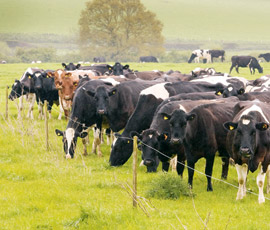Deferred grazing could reduce winter feed costs

Could setting aside land for winter grazing help reduce winter feed costs for spring calving beef and dairy cows? Debbie James finds out
Grazing cows and heifers on grassland set aside in August for winter pasture can significantly reduce feeding costs if the condition of animals can be maintained from grass alone.
According to Liz Genever, EBLEX Sheep and Beef Scientist, deferred grazing costs in the region of 6p/kg of DM while silage costs between 12p-14p/kg of DM.
“Deferred grazing can significantly reduce winter feed costs and as input costs are increasing farmers are revisiting this as a way of keeping cows out for longer,” says Dr Genever.
“The quality should be a similar level to a standing crop of hay with the advantage being that you don’t have the cost of conserving the forage because it is grazed in situ.”
This system involves the removal of livestock from grassland in the late summer to allow a grass wedge to build up for feeding in the late autumn and early winter.
To improve use and to preserve the swards, fields are grazed with the help of electric fencing. Back fencing is recommended to protect land that has been grazed.
Dr Genever says deferred grazing was not intended as a means of out-wintering animals but as a way of extending the grazing period. It can reduce the housing period for up to two months, she reckons.
Selecting fields suitable for extending grazing is crucial to its success. Pasture should have reasonably dense swards to protect it from weather damage and to minimise soil damage. Fields with longer-term leys or permanent pasture are ideally suited.
The grass should also be grazed well before the field is locked up, preferably to a height of 5cm. “In effect the pasture is being rested to grow high-quality feed instead of locking up older grass that has been trampled,” says Dr Genever.
She says the system can work well in spring calving beef and dairy herds, but it needs careful monitoring.
Body condition scores should be carefully observed; the system won’t suit every cow in the herd. Animals need to have a good body condition score and be at a point where they can afford to lose some weight.
“It’s a case of try it, monitor it and if it’s not working remove the animals, not necessarily all of them but the ones who are struggling,” advises Dr Genever.
The quality of the grass is important – a good percentage of leaf and live material is needed. When the grass is of poor quality, the condition of the animals can suffer. “Take a grass sample and get it analysed,” Dr Genever recommends.
Deferred grazing has been proven to work by the Jenkins family who conserve 90ha of off-lying land from mid-August to build covers to graze 110 spring-born calves.
A dressing of 50kg/ha of nitrogen is spread on the land at the beginning of September and the calves turned into the first paddock two weeks later. The leys are predominately long term, late heading perennial ryegrass.
The fields are divided into 0.3ha blocks with electric fencing and the heifers are given a fresh paddock every day. As the season progresses and the heifers get heavier, the paddock size increases to 0.45ha.
The heifers are British Friesians and New Zealand Friesians and they thrive on this system, said Eurig Jenkins, who farms in partnership with his father, Aeron, at Pentrefelin, Talsarn. “We don’t weigh the heifers but they grow really well on grass, they are a good size when they are put in calf.”
It was necessity not choice that prompted the Jenkins’ to adopt this system. They were expanding their spring-calving dairy herd – from 140 cows seven years ago to 330 this year – and didn’t have the sheds to house additional stock.
The establishment costs were minimal. The Jenkins’s were already renting the land as silage ground but instead of taking a third cut that grass was locked up for grazing. There was a one-off investment of £1,000 in electric fencing.
The fields are divided into square grazing blocks instead of rectangular paddocks because the cattle don’t need to walk as much to graze it thoroughly and are more settled in a square paddock. There is therefore less damage to the grass; even in wet conditions poaching has been minimal.
Although deferred grazing is labour intensive due to daily fence moves, it does enable farmers to increase herd size without investing in additional housing. In beef herds, it can facilitate taking animals through to finishing.
“If the animals that are being finished are due to be sold in November, cows can be kept outside until those animals go. It allows flexibility around that period,” explained Dr Genever.
To avoid breaching cross-compliance rules, fences should be regularly moved across the field, as with grazing brassicas, to keep sward damage to a minimum. A careful eye should be kept on areas around water tanks and consideration given to the option of using mobile tanks. If ring feeders are needed, these should be regularly moved to preserve the ground.
